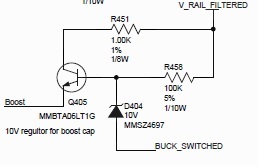We aren't sure what's happening with the TPS40054.
Basic design: 35-38V input
Output: 12-30V
Max power out: 150W
Problem: When the controller is forced off (using SS). And there is no load our output voltage creeps way up. We've tracked it down to leakage current going into the boost pin of the TPS40054 (~1.7mA). On new parts, this seems to be around 4-5V (<<1.7mA) which we consider to be OK) , but on a few boards we have seen this be 18V (~1.7mA into boost pin) which is unacceptable. This has been intermittent and we can't narrow it down to a certain condition that causes it. The only thing that fixes the issue is to replace the TPS40054 chip...
The boards where this has occurred have been handled quite a bit as they are prototypes; so, we think static might be an issue, but we want to rule out any major issues.
Note: We had to add a secondary charging circuit for the boost cap due to the high output voltage (30V). Otherwise low load regulation isn't possible with the TPS40054 alone (which of course is not anywhere in the spec sheet). The circuit charges the cap to 10V over the switched node voltage and doesn't require the switched node to be zero volts (which the TPS40054 requires for higher output voltage). We believe this could also be causing it, but the circuit is same across a bunch of boards with only a relative few problems and all the boards have been heavily stressed.
Any thoughts? The only one we have is to replace the 10V regulation with something lower... like 9V or 8V...
Thanks,
Kyle Miller


